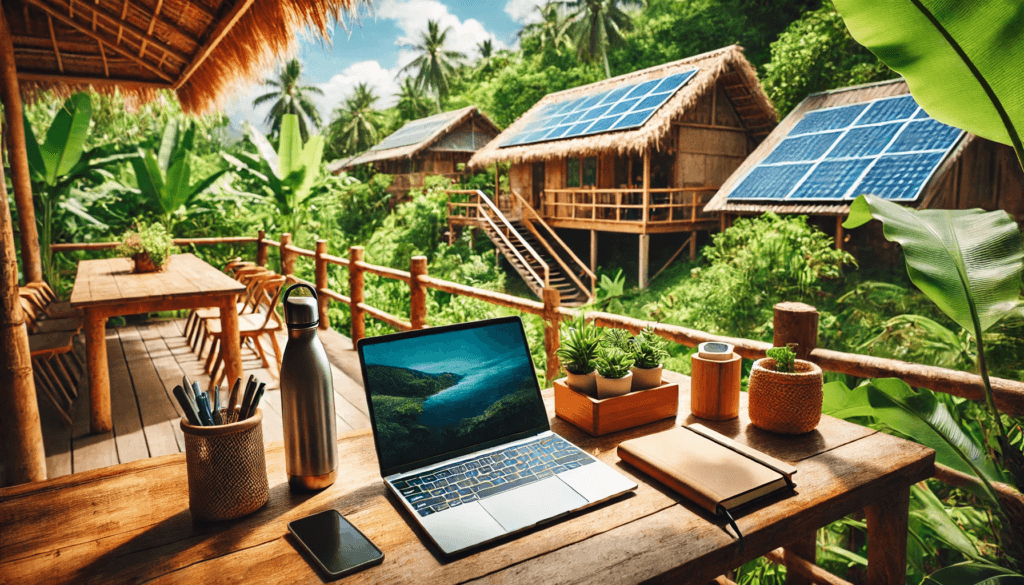The rise of digital nomadism has redefined modern work culture, blending professional productivity with global exploration. However, this lifestyle often comes with significant environmental costs, particularly through frequent travel, energy consumption, and waste generation. Recent studies estimate that tourism—a core component of nomadic life—accounts for 8% of global carbon emissions, with transportation and accommodation being the largest contributors. To address these challenges, a growing movement of eco-conscious nomads is adopting strategies to minimize their environmental impact. This report synthesizes actionable approaches for reducing carbon footprints while maintaining a location-independent lifestyle, drawing from sustainable transportation methods, eco-certified accommodations, low-waste product innovations, community-driven initiatives, and energy-efficient work practices.
Understanding the Environmental Impact of Digital Nomadism

The Carbon Footprint of Frequent Travel
Digital nomadism inherently relies on mobility, but this mobility carries ecological consequences. Air travel remains the most carbon-intensive aspect, with a single transatlantic flight generating approximately 1 ton of CO2 per passenger. While remote work eliminates daily commutes, nomadic lifestyles often involve more frequent long-haul flights than stationary living.
To mitigate travel emissions, nomads can choose eco-conscious services such as Kiwi, which invests in carbon offset programs and fuel-efficient aircraft. For additional tips on reducing flight costs while making eco-friendly choices, check out How to Get the Cheapest Flights Every Time.
Waste Generation in Transient Lifestyles
The transient nature of nomadic life leads to increased reliance on single-use plastics and disposable goods. Surveys indicate that 67% of digital nomads purchase bottled water due to safety concerns in developing countries, generating an average of 12 plastic bottles per week per individual. Switching to a sustainable Drimsim eSIM eliminates the need for plastic SIM cards while ensuring seamless global connectivity. More insights on securing reliable internet while traveling can be found in Staying Connected on the Road: Securing Reliable Internet for Digital Nomads.
Sustainable Transportation Strategies
Prioritizing Ground Transportation
Reducing air travel represents the most effective way to lower a nomad’s carbon footprint. For regional travel, trains emit 80% less CO2 per kilometer than planes, while long-distance buses cut emissions by 50%. Platforms like Travel Payouts help nomads book low-emission overland routes with ease.
When flying is unavoidable, selecting economy class flights on modern aircraft and booking non-stop flights can help minimize emissions. Using VPN services like NordVPN or PureVPN ensures safe online booking and secure transactions while on the move. Learn more about why VPNs are essential for digital nomads in Why Every Nomad Needs This VPN in 2025.
Local Mobility Solutions
Upon reaching destinations, nomads should adopt hyper-local transportation networks. Bike-sharing systems, ride-sharing apps, and solar-powered boat services reduce emissions significantly.

Eco-Conscious Accommodation Practices
Certifications and Green Infrastructure
Leading eco-certification programs help nomads identify sustainable lodging, from Green Key hotels to LEED-certified co-living spaces. Booking accommodations through Travel Payouts allows travelers to filter for eco-friendly stays while earning rewards.
Community-Driven Housing Models
Co-living spaces like Outsite and Selina’s Eco Hubs promote circular economy principles, integrating permaculture gardens, reusable kitchenware, and local reforestation initiatives.
Low-Waste Product Ecosystem
Reusable Travel Essentials
Transitioning to durable, multi-use products significantly reduces nomadic waste streams:
- Toiletries: Solid shampoo bars and bamboo toothbrushes cut down plastic waste.
- Dining Kits: Reusable stainless steel containers and straws eliminate disposables.
- Electronics: Solar chargers and modular phones extend gadget lifespan.
For those running an online business, platforms like Hostinger provide reliable web hosting solutions with a commitment to sustainability.
Energy-Efficient Work Practices
Optimizing Digital Workflows
Simple software adjustments can yield significant energy savings:
- Enabling dark mode on devices
- Using Ecosia as a search engine to plant trees
- Minimizing unnecessary browsing
Leveraging Make.com for automation reduces digital workload, leading to energy savings and increased efficiency.
Renewable Energy Adoption
Portable solar systems like the Jackery Solar Generator enable off-grid productivity. Additionally, SafetyWing Nomad Insurance provides essential coverage for health and travel, ensuring a worry-free lifestyle. More details on why SafetyWing is a top choice for nomads can be found in The Best Digital Nomad Insurance Options: Why SafetyWing Is #1.
Conclusion
For a deeper dive into the digital nomad lifestyle, check out The Ultimate Digital Nomad Guide 2025: Your Blueprint to a Borderless Life, which covers sustainable travel, remote work strategies, and passive income opportunities.
Additional Resources for Digital Nomads
- The Best Digital Nomad Insurance Options – Why SafetyWing is #1
- The 5 Best Future-Proof Laptops for Digital Nomads in 2025
- Staying Connected on the Road: Securing Reliable Internet for Digital Nomads
Recommended Tools & Resources for Digital Nomads
To further enhance your remote work experience, check out these expert resources:
- Dane Homenick’s Ultimate Guide to Travel Hacking Cheap Flights – Learn expert tips to book the cheapest flights every time, for just $7 with a 60-day risk-free guarantee.
- The Ultimate Digital Nomad Guide 2025 – AI-powered insights on remote work, passive income, and sustainable travel for a borderless lifestyle.
- Journo Travel Tips – Discover essential travel tips and hacks from seasoned travelers.
By following these strategies and using the right tools, digital nomads can ensure their work remains uninterrupted no matter where they are. With careful planning and a proactive approach, you can embrace the freedom of travel without compromising on connectivity.
Stay connected and happy travels! 🚀
Discover the best digital nomad insurance options and why SafetyWing is the top choice for flexible, affordable coverage. Read more here!












